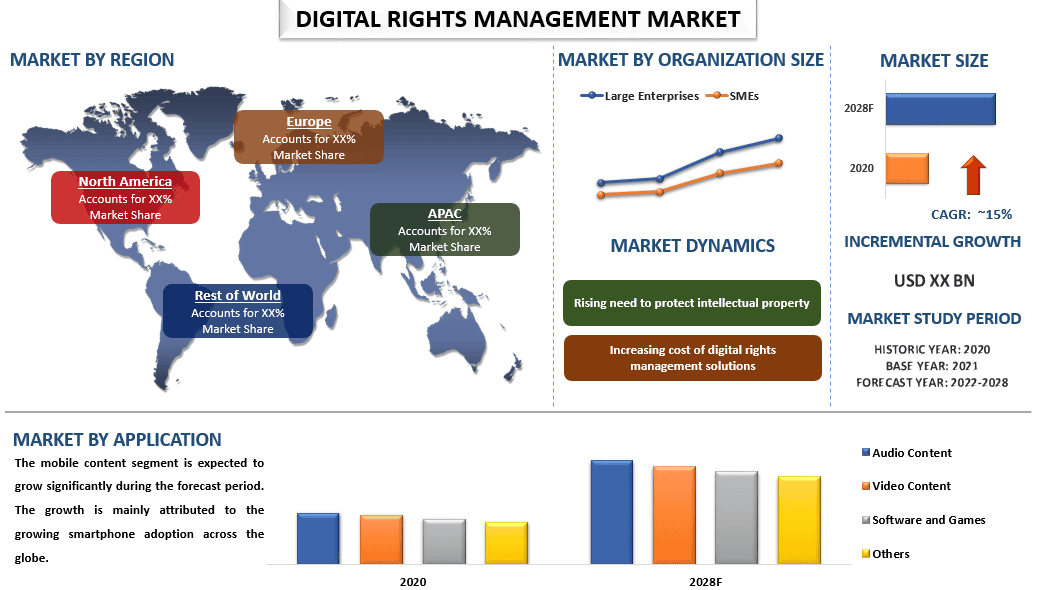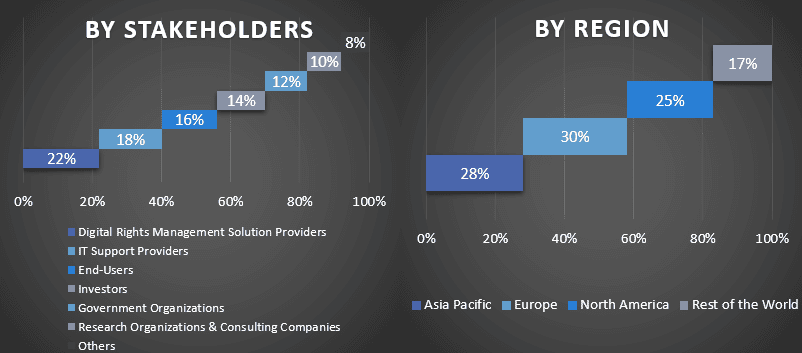- الرئيسية
- معلومات عنا
- صناعة
- الخدمات
- قراءة
- اتصل بنا
سوق إدارة الحقوق الرقمية: التحليل الحالي والتوقعات (2022-2028)
التركيز على التطبيق (محتوى صوتي، محتوى فيديو، برامج وألعاب، وغيرها)؛ حجم المؤسسة (المؤسسات الكبيرة والشركات الصغيرة والمتوسطة)؛ القطاعات الصناعية (الخدمات المصرفية والمالية، التعليم، الإعلام والترفيه، الرعاية الصحية، وغيرها)؛ والمنطقة/البلد

اطلب نموذجًا مجانيًا بتنسيق PDF
إدارة الحقوق الرقمية هي استخدام التكنولوجيا للتحكم في الوصول إلى المواد المحمية بحقوق الطبع والنشر وإدارتها. معنى آخر لإدارة الحقوق الرقمية هو سحب التحكم في المحتوى الرقمي من مالكه وتسليمه إلى برنامج كمبيوتر. تهدف إدارة الحقوق الرقمية إلى حماية حقوق مالكي حقوق الطبع والنشر وحماية المحتوى من التوزيع والتعديل غير المصرح به. تزداد أهمية إدارة الحقوق الرقمية مع انتشار المحتوى الرقمي من خلال مشاركة الملفات من نظير إلى نظير ومواقع التورنت والقرصنة عبر الإنترنت. فهي تساعد شركات الترفيه والإعلام على حماية نفسها من تحديات الأمن السيبراني التي تواجهها جميع الشركات، مثل حماية بيانات العملاء وضمان الامتثال وإثباته وتحسين الكفاءة التشغيلية وتجنب فترات التوقف.
من المتوقع أن ينمو سوق إدارة الحقوق الرقمية العالمي بمعدل نمو سنوي مركب يبلغ حوالي 15٪ خلال الفترة المتوقعة. يمكن أن يُعزى الاعتماد المتزايد لإدارة الحقوق الرقمية إلى الحاجة المتزايدة للشركات لحماية بياناتها بسبب الحاجة المتزايدة لسياسات حماية حقوق الطبع والنشر للملكية الفكرية الرقمية. علاوة على ذلك، فإن عوامل مثل الانتشار السريع للأجهزة والتقنيات الرقمية والتطوير المستمر للإنترنت كمنصة للأعمال والتجارة، وتحقيق الدخل الناجح من المحتوى الرقمي، والعدد المتزايد من مستخدمي وسائل التواصل الاجتماعي تساهم أيضًا في نمو السوق.
تعد Adobe Inc. و Apple Inc. و Dell Inc. و DivX LLC و Fortinet Inc. و IBM Corporation Inc. و Microsoft Corporation و NextLabs Inc. و Oracle Corporation و Sony Corporation من بين اللاعبين الرئيسيين في السوق. تم إجراء العديد من عمليات الاندماج والاستحواذ جنبًا إلى جنب مع الشراكات من قبل هؤلاء اللاعبين لتسهيل حصول العملاء على منتجات / تقنيات عالية التقنية ومبتكرة.
الرؤى المقدمة في التقرير
"من بين حجم المؤسسة، من المتوقع أن ينمو قطاع الشركات الصغيرة والمتوسطة بمعدل نمو سنوي مركب بارز"
حسب حجم المؤسسة، ينقسم سوق إدارة الحقوق الرقمية إلى مؤسسات كبيرة وشركات صغيرة ومتوسطة. من المتوقع أن ينمو قطاع الشركات الصغيرة والمتوسطة بمعدل نمو سنوي مركب أكبر خلال الفترة المتوقعة. ويرجع ذلك بشكل أساسي إلى انتقالها إلى دعم البيانات وأنظمة إدارة البيانات، وتوظف الشركات الصغيرة والمتوسطة حلول إدارة الحقوق الرقمية للمؤسسات بمعدل مرتفع للغاية. وقد لوحظ أن عددًا متزايدًا من الشركات الصغيرة والمتوسطة الحجم تقوم باستثمارات كبيرة في برامج إدارة الحقوق الرقمية للمؤسسات.
"من بين القطاعات الصناعية، استحوذ قطاع إدارة الأداء على حصة كبيرة من السوق في عام 2020"
على أساس القطاعات الصناعية، يتم تقسيم السوق إلى الخدمات المصرفية والمالية والتعليم والإعلام والترفيه والرعاية الصحية وغيرها. من المتوقع أن ينمو قطاع الإعلام والترفيه بشكل كبير خلال الفترة المتوقعة. يُعزى هذا بشكل أساسي إلى الأهمية المتزايدة لـ OTT. علاوة على ذلك، من المتوقع أيضًا أن يؤدي تزايد انتشار وسائل التواصل الاجتماعي إلى دفع السوق خلال الفترة المتوقعة.
"من المتوقع أن تحتفظ أمريكا الشمالية بحصة كبيرة في السوق"
احتفظت منطقة أمريكا الشمالية بحصة بارزة في سوق إدارة الحقوق الرقمية العالمي في عام 2020 ومن المتوقع أن تنمو بمعدل نمو كبير خلال الفترة المتوقعة. من المتوقع أن يؤثر الارتفاع في الهواتف الذكية والأجهزة اللوحية والاعتماد على الإنترنت بين العملاء في المنطقة بشكل كبير على نمو السوق. علاوة على ذلك، من المتوقع أيضًا أن تؤدي المخاطر المتزايدة للهجمات الإلكترونية في المنطقة إلى دفع السوق. على سبيل المثال، وفقًا لشركة IBM Corporation، في عام 2020، بلغ متوسط تكلفة خرق البيانات 3.86 مليون دولار أمريكي على مستوى العالم و 8.64 مليون دولار أمريكي في الولايات المتحدة. تشمل هذه التكاليف نفقات اكتشاف الخرق والاستجابة له، وتكلفة التوقف عن العمل والإيرادات المفقودة، والأضرار التي تلحق بسمعة الشركة وعلامتها التجارية على المدى الطويل.
أسباب شراء هذا التقرير:
- تتضمن الدراسة تحليل حجم السوق والتنبؤ به تم التحقق منه من قبل خبراء الصناعة الرئيسيين الموثوق بهم.
- يقدم التقرير مراجعة سريعة للأداء العام للصناعة في لمحة واحدة.
- يغطي التقرير تحليلًا متعمقًا لنظراء الصناعة البارزين مع التركيز الأساسي على البيانات المالية التجارية الرئيسية والمحافظ الاستثمارية للمنتجات واستراتيجيات التوسع والتطورات الأخيرة.
- فحص مفصل للدوافع والقيود والاتجاهات الرئيسية والفرص السائدة في الصناعة.
- تغطي الدراسة بشكل شامل السوق عبر قطاعات مختلفة.
- تحليل متعمق على المستوى الإقليمي للصناعة.
خيارات التخصيص:
يمكن زيادة تخصيص سوق إدارة الحقوق الرقمية العالمي وفقًا للمتطلبات أو أي قطاع سوقي آخر. إلى جانب ذلك، تدرك UMI أن لديك احتياجات عمل خاصة بك، لذا لا تتردد في التواصل معنا للحصول على تقرير يناسب متطلباتك تمامًا.
جدول المحتويات
منهجية البحث لتحليل سوق إدارة الحقوق الرقمية (2022-2028)
كان تحليل السوق التاريخية، وتقدير السوق الحالية، والتنبؤ بالسوق المستقبلية لسوق إدارة الحقوق الرقمية العالمي، هي الخطوات الرئيسية الثلاث التي تم اتخاذها لإنشاء وتحليل اعتماد إدارة الحقوق الرقمية في المناطق الرئيسية على مستوى العالم. تم إجراء بحث ثانوي شامل لجمع أرقام السوق التاريخية وتقدير حجم السوق الحالي. ثانيًا، للتحقق من صحة هذه الرؤى، تم أخذ العديد من النتائج والافتراضات في الاعتبار. علاوة على ذلك، تم إجراء مقابلات أولية شاملة أيضًا مع خبراء الصناعة عبر سلسلة القيمة لسوق إدارة الحقوق الرقمية العالمي. بعد افتراض أرقام السوق والتحقق من صحتها من خلال المقابلات الأولية، استخدمنا نهجًا من أعلى إلى أسفل/من أسفل إلى أعلى للتنبؤ بحجم السوق الكامل. بعد ذلك، تم اعتماد طرق تقسيم السوق وتثليث البيانات لتقدير وتحليل حجم سوق القطاعات والقطاعات الفرعية للصناعة ذات الصلة. يتم شرح المنهجية التفصيلية أدناه:
تحليل حجم السوق التاريخي
الخطوة 1: دراسة متعمقة للمصادر الثانوية:
تم إجراء دراسة ثانوية تفصيلية للحصول على حجم السوق التاريخي لسوق إدارة الحقوق الرقمية من خلال مصادر الشركة الداخلية مثل التقارير السنوية والبيانات المالية، وعروض الأداء، والنشرات الصحفية، وما إلى ذلك، والمصادر الخارجية بما في ذلك المجلات والأخبار والمقالات والمنشورات الحكومية ومنشورات المنافسين وتقارير القطاعات وقاعدة بيانات الطرف الثالث والمنشورات الموثوقة الأخرى.
الخطوة 2: تجزئة السوق:
بعد الحصول على حجم السوق التاريخي لسوق إدارة الحقوق الرقمية، أجرينا تحليلًا ثانويًا تفصيليًا لجمع رؤى السوق التاريخية وحصصها للقطاعات والقطاعات الفرعية المختلفة للمناطق الرئيسية. يتم تضمين القطاعات الرئيسية في التقرير مثل التطبيق وحجم المؤسسة والقطاعات الصناعية. تم إجراء المزيد من التحليلات على مستوى الدولة لتقييم الاعتماد الكلي لنماذج الاختبار في تلك المنطقة.
الخطوة 3: تحليل العوامل:
بعد الحصول على حجم السوق التاريخي للقطاعات والقطاعات الفرعية المختلفة، أجرينا تحليل عوامل مفصل لتقدير حجم السوق الحالي لسوق إدارة الحقوق الرقمية. علاوة على ذلك، أجرينا تحليل العوامل باستخدام المتغيرات التابعة والمستقلة مثل التطبيق وحجم المؤسسة والقطاعات الصناعية لإدارة الحقوق الرقمية. تم إجراء تحليل شامل لسيناريوهات جانب الطلب والعرض مع الأخذ في الاعتبار أهم الشراكات وعمليات الدمج والاستحواذ والتوسع التجاري وإطلاق المنتجات في قطاع سوق إدارة الحقوق الرقمية في جميع أنحاء العالم.
تقدير حجم السوق الحالي والتنبؤ به
تقدير حجم السوق الحالي: بناءً على رؤى قابلة للتنفيذ من الخطوات الثلاث المذكورة أعلاه، توصلنا إلى حجم السوق الحالي واللاعبين الرئيسيين في سوق إدارة الحقوق الرقمية العالمي والحصص السوقية للقطاعات. تم تحديد جميع حصص النسبة المئوية المطلوبة وتقسيمات السوق باستخدام النهج الثانوي المذكور أعلاه وتم التحقق منها من خلال المقابلات الأولية.
التقدير والتنبؤ: لتقدير السوق والتنبؤ بها، تم تعيين أوزان لعوامل مختلفة بما في ذلك المحركات والاتجاهات والقيود والفرص المتاحة لأصحاب المصلحة. بعد تحليل هذه العوامل، تم تطبيق تقنيات التنبؤ ذات الصلة، أي النهج من أعلى إلى أسفل/من أسفل إلى أعلى للتوصل إلى توقعات السوق لعام 2028 للقطاعات والقطاعات الفرعية المختلفة عبر الأسواق الرئيسية على مستوى العالم. تتضمن منهجية البحث المعتمدة لتقدير حجم السوق ما يلي:
- حجم سوق الصناعة، من حيث الإيرادات (بالدولار الأمريكي) ومعدل اعتماد سوق إدارة الحقوق الرقمية عبر الأسواق الرئيسية محليًا
- جميع الحصص المئوية وتقسيمات وتقسيمات فرعية لقطاعات السوق وقطاعاتها الفرعية
- اللاعبون الرئيسيون في سوق إدارة الحقوق الرقمية العالمي من حيث المنتجات المعروضة. أيضًا، استراتيجيات النمو التي يتبناها هؤلاء اللاعبون للتنافس في السوق سريع النمو
التحقق من صحة حجم السوق وحصتها
البحث الأولي: تم إجراء مقابلات متعمقة مع قادة الرأي الرئيسيين (KOLs) بما في ذلك كبار المسؤولين التنفيذيين (CXO/VPs ورئيس المبيعات ورئيس التسويق والرئيس التشغيلي والرئيس الإقليمي والرئيس القطري وما إلى ذلك) عبر المناطق الرئيسية. ثم تم تلخيص نتائج البحث الأولي وإجراء تحليل إحصائي لإثبات الفرضية المذكورة. تم دمج المدخلات من البحث الأولي مع النتائج الثانوية، وبالتالي تحويل المعلومات إلى رؤى قابلة للتنفيذ.
توزيع المشاركين الأساسيين في مناطق مختلفة

هندسة السوق
تم استخدام تقنية تثليث البيانات لإكمال تقدير السوق الإجمالي والتوصل إلى أرقام إحصائية دقيقة لكل قطاع وقطاع فرعي من سوق إدارة الحقوق الرقمية العالمي. تم تقسيم البيانات إلى عدة قطاعات وقطاعات فرعية بعد دراسة المعايير والاتجاهات المختلفة في مجالات التطبيق وحجم المؤسسة والقطاعات الصناعية في سوق إدارة الحقوق الرقمية العالمي.
الهدف الرئيسي لدراسة سوق إدارة الحقوق الرقمية العالمي
تم تحديد اتجاهات السوق الحالية والمستقبلية لسوق إدارة الحقوق الرقمية العالمي في الدراسة. يمكن للمستثمرين الحصول على رؤى استراتيجية لأساس تقديرهم للاستثمارات بناءً على التحليل النوعي والكمي الذي تم إجراؤه في الدراسة. حددت اتجاهات السوق الحالية والمستقبلية الجاذبية الإجمالية للسوق على المستوى الإقليمي، مما يوفر منصة للمشارك الصناعي لاستغلال السوق غير المستغلة للاستفادة من ميزة المحرك الأول. تشمل الأهداف الكمية الأخرى للدراسات ما يلي:
- تحليل حجم السوق الحالي والمتوقع لسوق إدارة الحقوق الرقمية من حيث القيمة (بالدولار الأمريكي). أيضًا، تحليل حجم السوق الحالي والمتوقع للقطاعات والقطاعات الفرعية المختلفة
- تشمل القطاعات في الدراسة مجالات التطبيق وحجم المؤسسة والقطاعات الصناعية
- تحديد وتحليل الإطار التنظيمي لصناعة إدارة الحقوق الرقمية
- تحليل سلسلة القيمة المتضمنة في وجود وسطاء مختلفين، جنبًا إلى جنب مع تحليل سلوكيات العملاء والمنافسين في الصناعة
- تحليل حجم السوق الحالي والمتوقع لسوق إدارة الحقوق الرقمية للمنطقة الرئيسية
- تشمل الدول الرئيسية في المناطق التي تمت دراستها في التقرير منطقة آسيا والمحيط الهادئ وأوروبا وأمريكا الشمالية وبقية العالم
- الملفات التعريفية للشركات في سوق إدارة الحقوق الرقمية واستراتيجيات النمو التي يتبناها اللاعبون في السوق للحفاظ على النمو في السوق سريع النمو
- تحليل متعمق على المستوى الإقليمي للصناعة
ذات صلة التقارير
العملاء الذين اشتروا هذا المنتج اشتروا أيضًا










